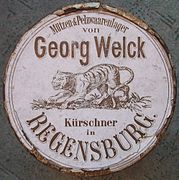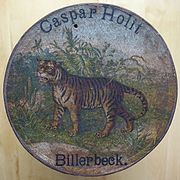Muffle box
A Muffkarton even Muffschachtel , is usually made of laminated cardboard produced container for the hand warmer muff . It protects the contents from insect infestation, fading from exposure to light and dust.
While there were also sleeves for men in the Middle Ages , they had been an integral part of the women's wardrobe since the end of the 19th century, lastly decreasing until around the 1950s. After the Second World War (1939–1945), muff boxes were favored by fashion to a much lesser extent and only sporadically. Accordingly, muff boxes have probably hardly been made since then.
General
Muff consists of a muff bag filled with warming material, the upper material is usually fur.
In the Middle Ages and afterwards, fur was worn almost exclusively as fur-lined and fur-trimmed clothing. Towards the end of the 19th century, fur trimmings in particular, collections of small fur accessories, became fashionable. These were mainly sleeve, fur ties or fur scarves, Pelzkolliers , fur hats and possibly Pelzfäustlinge.
An early document for a muffle box can be found in the farce "Bride and Groom in One Person" by August von Kotzebue from 1814. There, Count von Hottentott hides under a mountain of laundry, his head hidden in a muffle box. The situation apparently came to a head when the brother of Friderike von Aarau, who was in the room, announced that he wanted to practice target practice with his newly acquired pistols. He would like to replace the sable or marten muff that she quickly claimed to be in .
While hat boxes were also available in elaborate designs in addition to the extra when purchasing, muff and fur tie boxes were probably always a free purchase.
Before putting the muff in the box over the summer, make sure that it is not infested with insects. To do this, it is recommended to knock it out thoroughly . Since this is not always easy with a muff with a possibly moth- prone down filling , it made sense to include mothballs or an insect powder.
The cardboard boxes clearly served their intended purpose of protecting the muff. Even today, over a hundred year old muffle boxes with well-preserved contents are offered for sale on the Internet. An indication of the age of the Muffkartons has an inscription like " Rauchwaarenlager ". The spelling with the double a ("aa") was abolished with the spelling reform of 1901.
Executions
The muffle box differs from its close relative, the hat box , primarily in its shape, which is less wide and more tube-like, which is adapted to the product. The round shape corresponds to the so-called "barrel muff", flat socket including the pocket socket can be better accommodated in angular shapes. In the more elaborate variant, there is a removable longitudinal rod in the box, over which the muff is pulled so that it does not lie on the floor. The hair cannot be crushed when lying down for a long time. While hat boxes are more often made of chipboard, wood, metal or leather, muff boxes seem to be made of cardboard almost without exception. In the simple, usually round muffle boxes, the muff is stored upright so that it rests on one engagement side, while the box with the muff bar is angular. Occasionally the boxes had a metal handle or two on them. Sometimes a sheet metal edge on the edges improved the wear resistance.
In 1872, the American Ralph S. Jennings applied for a patent for a metal muff box, the inside of which was completely lined with cedar wood, which was considered to protect against moths . At the beginning of the 20th century, Paul Heussi from Leipzig offered similar, but also equipped with moth-resistant camphor wood , under the name " Mottenkapsel" or "Pelzkapsel ".
The company H. Pohl in Leipzig-Plagwitz, Kartonagenfabrik for fur and hat industry, advertised in 1914 " Necklace cartons, Taschenmuff cartons, collars and ties cartons, from the simplest to the finest genre". While the round muffle boxes took up a lot of storage space in retail stores, the company also offered square, collapsible boxes, at least for women's hats.
As a purchase and at the same time promotional items, the boxes usually have advertising labels, some of which are artistically designed. There are many images of fur-bearing animals, especially those whose skins are almost never used by furriers , such as lions, tigers and bears. The cardboard lid from the Albert Struszewski fur goods, hat and cap warehouse from Bitterfeld shows five animals used for fur purposes, some of which can be recognized as members of the zoological family of the marten, executed in an elaborate embossing .
Since the furrier shops usually offer summer storage for furs , there is often a text on the inside lid of the boxes, such as: "Furs are accepted for storage against moth and fire damage".
- Illustrations on muffle boxes
See also
Web links
Individual evidence
- ↑ August von Kotzebue: Bride and groom in one person . Theater of August v. Kotzebue , Volume 30, Ignaz Klang, Vienna and Eduard Kummer, Leipzig, 1941, p. 78ff. Last accessed November 22, 2019.
- ↑ Muffkarton of Georg steel, Windheim .
- ↑ Muffkarton of Friedrich Koch Hall .
- ↑ Muffkarton the company Ferd. Kalman, Berlin .
- ^ Ralph S. Jennings: Improvement in Muff Boxes . April 25, 1872 (English). Last accessed on November 22, 2019.
- ^ Advertisement by Heussi's Mottenkapsel , 1909.
- ^ Advertisement by H. Pohl, 1914 .
- ↑ Muffkarton of Albert Struszewski, Bitterfeld .
- ↑ Inner cover from Aug. Antholz, Krefeld.
- ↑ Inner cover from Bernhard Funke, Weißenfels.
- ↑ Inside cover from Julius Heinig, Penig .







